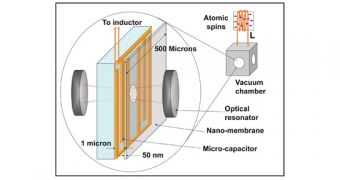Quantum computing is considered, by many, the next leap in technological advancement, so physicists from the Joint Quantum Institute (JQI), the Neils Bohr Institute in Copenhagen, Denmark, and Harvard University have decided to team up.
Hearing that researchers want to make a nanosized loudspeaker may give the wrong idea to those who only heard the term during discussions about stereo systems and the like.
Fortunately, the physicists who seek to achieve this breakthrough made their goals more than clear.
Basically, they wish to demonstrate a theory that describes how to detect weak electrical signals and cool electrical circuits using light and a nanosized loudspeaker.
If successful, the method will make it easy to detect low-power radio signals and will also help advance the field of quantum information science, as well as MRI (magnetic resonance imaging).
“We envision coupling a nanomechanical membrane to an electrical circuit so that an electrical signal, even if exceedingly faint, will cause the membrane to quiver slightly as a function of the strength of that signal,” says JQI physicist Jake Taylor.
“We can then bounce photons from a laser off that membrane and read the signal by measuring the modulation of the reflected light as it is shifted by the motion of the membrane. This leads to a change in the wavelength of the light.”
The reason MRI medical procedures would benefit greatly from a positive result in this area is that the signal strength would not have to be so high anymore.
MRI machines are very large because they have many superconducting magnets inside. A reduction in signal strength requirements would bring down the size and make equipment much more compact and effective.
Moving on, some may remember that Qubits are being considered for more secure cloud computing.
It so happens that the research team believes that a Qubit-based quantum information system could exploit the “inherent weirdness” of quantum phenomena to perform calculations impossible for existing computers (light will be used to transfer information among qubits as well).
Finally, the cooling system will be included for free, as the translation of the mechanical motion of the small loudspeaker into photons will drain the heat from the system on its own.
If anyone really wants to make better sense of all this, they may as well go here and read more.

 14 DAY TRIAL //
14 DAY TRIAL //